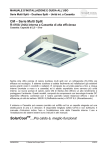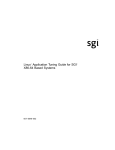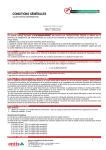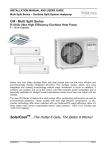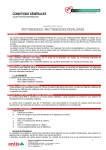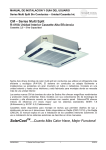Download SGI® UVTM System Management Node Administrator Guide
Transcript
SGI® UVTM System Management Node Administrator Guide 007–5694–010 COPYRIGHT © 2010–2013 SGI. All rights reserved; provided portions may be copyright in third parties, as indicated elsewhere herein. No permission is granted to copy, distribute, or create derivative works from the contents of this electronic documentation in any manner, in whole or in part, without the prior written permission of SGI. LIMITED RIGHTS LEGEND The software described in this document is "commercial computer software" provided with restricted rights (except as to included open/free source) as specified in the FAR 52.227-19 and/or the DFAR 227.7202, or successive sections. Use beyond license provisions is a violation of worldwide intellectual property laws, treaties and conventions. This document is provided with limited rights as defined in 52.227-14. TRADEMARKS AND ATTRIBUTIONS Altix, SGI, the SGI logo, and UV are are trademarks or registered trademarks of Silicon Graphics International Corp. or its subsidiaries in the United States and other countries. Firefox and Mozilla are registered trademarks of the Mozilla Foundation. Linux is a registered trademark of Linus Torvalds in the United States and other countries. Microsoft and Windows are registered trademarks or trademarks of Microsoft Corporation in the United States and/or other countries. Novell and SUSE are registered trademarks of Novell, Inc., in the United States and other countries. Red Hat and all Red Hat-based trademarks are trademarks or registered trademarks of Red Hat, Inc. in the United States and other countries. SUPERMICRO is a registerd trademark of Super Micro Computer, Inc. All other trademarks mentioned herein are the property of their respective owners. New Features in This Manual This rewrite of the SGI UV System Management Node Administrator Guide supports the SGI System Management Node 1.7 release. The installation and configuration information that used to reside in this manual has been updated and removed to the SGI UV Systems Software Installation Guide. The SGI UV Systems Software Installation Guide contains information about how to install and configure operating system software, SGI Foundation Software, and System Management Node (SMN) software on the SMN and on the SGI UV server. Information about SMN commands has been rewritten. An appendix section that includes information about network topology on SGI UV 2000 and SGI UV 1000 systems has been added. 007–5694–010 iii Record of Revision 007–5694–010 Version Description 001 October 2010 Original Printing. 002 February 2011 Updated to support the SGI Foundation Software 2.3 release. 003 February 2011 Updated to support additional changes for the SGI Foundation Software 2.3 release. 004 February 2011 Updated to add information about remote console and reinstalling operating system software. 005 March 2011 Updated to support additional changes for the SGI Foundation Software 2.3 release. 006 April 2011 Updated to support changes for the SGI Foundation Software 2.4 release. 007 July 2011 Updated to support additional changes for the SGI Foundation Software 2.4 release. 008 September 2011 Updated to support additional changes for the SGI Foundation Software 2.4 release. 009 May 2012 Updated to support changes for the SGI System Management Node 1.5 release. 010 May 2013 Updated to support the SGI System Management Node 1.7 release. v Contents About This Manual Obtaining Publications . . . . . . . . . . . . . Related Publications and Other Sources Conventions . . Reader Comments . . . . . . . . . . . . . ix . . . . . . . . . . . . . . . . ix . . . . . . . . . . . . . . . . ix . . . . . . . . . . . . . . . . . . . . . . . x . . . . . . . . . . . . . . . . . . . . . . . x . . . . . . 1 1. Introduction . . . . . . . . . . . . System Management Node Software and Documentation Logging in to the System Management Node . . . . . . . . . . . . . . . . 1 . . . . . . . . . . . . . . 2 . . . . . . . . . . . . . . 3 Chassis Management Controller (CMC) and System Management Node (SMN) Commands 3 Managing Multiple, Individual SGI UV Systems or Single System Images (SSIs) From a Single SMN . . . . . . . . . . . . . . . . . . . . . . . . . . 5 Specifying Unique SGI UV System Targets System Management Node (SMN) Commands SMN RPMs for Single System Images (SSIs) 2. System Network Addressing . . . . . . . . . . . . . . . 6 . . . . . . . . . . . . . . . 7 . . . . . . 9 . . . . . . . . . . System Network Addressing Overview . . . . . . . . . . . . . . . . 9 System Management Node Ethernet Ports . . . . . . . . . . . . . . . . 10 eth1smn . . . . . . . . . . . . . . . . . . . . . . . . . 10 eth2smn . . . . . . . . . . . . . . . . . . . . . . . . . 11 eth3smn . . . . . . . . . . . . . . . . . . . . . . . . . 11 . . . . . . . . . . . . . . . . . 12 . . . . . . . . . . . 12 . . . . . . . . . . . 13 SGI UV CMC IP Address Assignment Multiple SGI UV Partitions or Systems on a Single SMN Non SGI UV Systems on the SMN 007–5694–010 . . . . . . . vii Contents SMN Firewall Capabilities . . . . . . . . . 3. Simple Network Management Protocol SNMP Agent Overview . . . Verifying the SMN Software Stack SNMP Configuration . . . . . . . . . . . . . . . . . . . . . . . . 13 . . . . . . 15 . . . . . . . . . . . . . . . . . . 15 . . . . . . . . . . . . . . . . . . 16 . . . . . . . . . . . . . . . . . . 20 . . . . . . . . . . . . 20 . . . . . . . . . . . . 21 . . 23 . 23 Automatic Configuration Using uv_snmpconfig Manual Configuration . . . Appendix A. Network Topology . . . . . . . . . . . . . . . . . . About the System Control Network on SGI UV 2000 Systems and SGI UV 1000 Systems SGI UV 2000 Network Topology . . Single IRU System Control Cabling . . . . . . . . . . . . . . . . . 24 . . . . . . . . . . . . . . . . . 24 . . . . 26 . . . 28 One Single System Image (SSI) System Management Node (SMN) Network Multiple Single System Image (SSI) System Management Node (SMN) Network Two Systems, One Single System Image (SSI) System Management Node (SMN) Network SGI UV 1000 Network Topology Physical Connections 30 . . . . . . . . . . . . . . . . . . . 32 . . . . . . . . . . . . . . . . . . . . . 32 . . . . . . . . . . . . . . . . . . . . . . 34 Discovery and Failover . . . . . . . . . . . . . . . . . . . . . 35 . . 41 VLANs Index viii . . . . . . . . . . . . . . . . . . . . . . . . . . . . 007–5694–010 About This Manual This manual describes how to use the system management node (SMN), which is an administrative computer for SGI® UVTM 2000, SGI® UVTM 1000, and SGI® UVTM 100 systems. An SMN is required for SGI UV 1000 systems. An SMN is optional for SGI UV 2000 systems and SGI UV 100 systems. Obtaining Publications You can obtain SGI documentation in the following ways: • You can access user guides and reference manuals from the SGI Technical Publications Library at the following website: http://docs.sgi.com. Various formats are available. This library contains the most recent and most comprehensive set of online books, release notes, man(1) pages, and other information. • You can log into an SGI system and retrieve Linux man(1) pages for a particular topic title. Type man title on a command line. Related Publications and Other Sources The SGI UV Systems Software Install Guide describes how to install operating system software, SMN software, and SGI Foundation Software on SGI UV 2000, SGI UV 1000, and SGI UV 100 systems. The SGI Foundation Software X.X Start Here contains a list of manuals that can be useful to SMN administrators. For information about the optional SGI Management Center (SMC) software, see the following: • SGI Management Center (SMC) Installation and Configuration • SGI Management Center (SMC) System Administrator Guide 007–5694–010 ix About This Manual The SGI Knowledgebase has been updated to include advanced information that pertains to the SMN. Your SGI representative can assist you in obtaining information from the SGI Knowledgebase about the following: • How to flash the BMC and CMC firmware. • How to flash the LG-E or Edge-corE switch firmware. • How to boot using the iSCSI protocol or how to boot from a Fibre Channel disk. Conventions The following conventions are used throughout this document: Convention Meaning command This fixed-space font denotes literal items such as commands, files, routines, path names, signals, messages, and programming language structures. manpage(x) Man page section identifiers appear in parentheses after man page names. variable Italic typeface denotes variable entries and words or concepts being defined. user input This bold, fixed-space font denotes literal items that the user enters in interactive sessions. (Output is shown in nonbold, fixed-space font.) [] Brackets enclose optional portions of a command or directive line. ... Ellipses indicate that a preceding element can be repeated. Reader Comments If you have comments about the technical accuracy, content, or organization of this publication, contact SGI. Be sure to include the title and document number of the publication with your comments. (Online, the document number is located in the x 007–5694–010 SGI® UVTM System Management Node Administrator Guide front matter of the publication. In printed publications, the document number is located at the bottom of each page.) You can contact SGI in any of the following ways: • Send e-mail to the following address: [email protected] • Contact your customer service representative and ask that an incident be filed in the SGI incident tracking system. • Send mail to the following address: SGI Technical Publications 46600 Landing Parkway Fremont, CA 94538 SGI values your comments and will respond to them promptly. 007–5694–010 xi Chapter 1 Introduction This chapter includes the following topics: • "System Management Node Software and Documentation" on page 1 • "Logging in to the System Management Node" on page 2 • "System Management Node (SMN) Commands" on page 3 • "SMN RPMs for Single System Images (SSIs)" on page 7 System Management Node Software and Documentation The SMN requires the following software: • Operating system software, which can be either SUSE Linux Enterprise Server 11 or Red Hat Enterprise Linux 6 • SGI Foundation Software • SGI System Management Node Software In addition to the preceding list of required software, you might want to install the SGI Management Center (SMC) software. SMC provides a graphical user interface tool that enables you to initiate management actions and monitor essential system metrics. To verify the software on your SMN, type the following command: smn:~ # cat /etc/*release SGI provides documentation on the documentation website at http://docs.sgi.com. In addition, documentation is included in the SMN software packages. You can access the SMN documentation on your SMN in one of the following ways: • To retrieve the location of the SMN release notes, type the following command: smn:~ # rpm -qld sgi-smn-release • To retrieve the locations for the PDF and HTML versions of this manual, the SGI UV System Management Node Administrator Guide, type the following command: smn:~ # rpm -qld sgi-smn-docs 007–5694–010 1 1: Introduction • To retrieve a menu that lists additional documentation, type the following relnotes(8) command: smn:~ # relnotes -b smn After you make a selection from the menu, the system starts the appropriate viewing tool and presents your selection. The relnotes(8) command displays PDFs or other graphical documentation when X11 forwarding is enabled. To enable X11 forwarding, log into the SMN with a command similar to the following: smn:~ # ssh -X root@my-smn For example: smn:~ # relnotes -b smn NOTICE: Found only one(1) PDF viewer : /usr/bin/evince NOTICE: Found multiple HTML viewers : /usr/bin/firefox /usr/bin/lynx,no 1 sgi-smn-1 SGI-SMN-1.7-readme.txt 2 sgi-smn-1 SGI-SMN-1.7-rpms.txt 3 sgi-smn-1 UV_mannode_AG/pdf/UV_mannode_AG.pdf 4 sgi-smn-1 UV_mannode_AG/sgi_html/index.html File number (h or ? for help) [1] : 3 ... Using /usr/bin/evince # NOTE: At this point, the PDF viewer starts on the desktop. 4 sgi-smn-1 UV_mannode_AG/sgi_html/index.html File number (h or ? for help) [4] : 4 1 /usr/bin/firefox 2 /usr/bin/lynx Choose viewer (h or ? for help) [Default=1] : # NOTE: At this point, select the browser. Logging in to the System Management Node The following procedure explains how to log into the SMN. Procedure 1-1 To log into the SMN 1. Type the following command to log into the SMN: # ssh -X sysco@uv-system-smn 2. Type the password for the SMN. 2 007–5694–010 SGI® UVTM System Management Node Administrator Guide By default, the password is sysco. 3. (Optional) Type the following to list the SMN commands: # /sysco/bin/help System Management Node (SMN) Commands The SGI UV system includes some commands that are available only on the SMN and others that are available on both the SMN and the chassis management controller (CMC). For information about how to log into the CMC and enter commands from the CMC, see the SGI UV CMC Software User Guide. The following topics describe the SMN commands: • "Chassis Management Controller (CMC) and System Management Node (SMN) Commands" on page 3 • "Managing Multiple, Individual SGI UV Systems or Single System Images (SSIs) From a Single SMN" on page 5 • "Specifying Unique SGI UV System Targets" on page 6 Chassis Management Controller (CMC) and System Management Node (SMN) Commands Table 1-1 on page 3 lists the CMC commands, lists the SMN commands, and shows platform availability. To obtain more information about any of these commands, type the following: command_name --help Table 1-1 CMC and SMN Commands 007–5694–010 3 1: Introduction 4 Command Availability Action auth CMC, SMN Authenticates system serial number (SSN) changes and sets the average peak performance in weighted teraflops (APPWT) limit for export compliance. You can obtain this key and reset the limit if needed. autopower CMC, SMN Allows your system to power up automatically when power is applied after a power outage. Issuing the autopower command without an argument acts as a query, with the results displaying the current state (enabled/disabled) and (if enabled) the current delay time and the results of the last attempted automatic power on. baseiolist SMN For each Base I/O BMC, lists the IP addresses, system serial number (SSN), Base I/O hostname, CMC hostname, and CMC IP address for the SGI UV systems attached to the SMN. This command requires the smnd daemon to be running. bios CMC, SMN Displays BIOS information for the system after it is powered on. bmc CMC, SMN Sends a command to one or more BMCs. It is a shell command similar in behavior to the ssh command. cmc CMC, SMN Sends a command to one or more CMCs. It is a shell command similar in behavior to the ssh command. config CMC, SMN Displays the system configuration. console CMC, SMN Opens a console window on the CMC, BMC, or compute blade. Type CTRL -] q to exit the console. help CMC, SMN Displays the hardware error logs. hel CMC, SMN Displays the hardware error logs. hwcfg CMC, SMN Displays and sets hardware override variables. leds SMN Displays system LED values. log CMC, SMN Provides a log of various operations performed on the CMC. 007–5694–010 SGI® UVTM System Management Node Administrator Guide Command Availability Action power CMC, SMN Accesses power control/status. The power command is also available on the chassis management controller (CMC). When a power command is issued, it checks to see if the individual rack units (IRUs) are powered on. If not on, the power command powers up the IRUs and then powers up the blades in the IRUs. /smnbackup SMN Creates a tar(1) file and, optionally, other system files for the SMN. For more information, type the following command: # /smnbackup --help uv_con SMN Collects all SMN UV Base I/O UV consoles locally for consultation purposes. Managing Multiple, Individual SGI UV Systems or Single System Images (SSIs) From a Single SMN You can configure one SMN to manage multiple SGI UV systems. If you need to run SMN commands on only one system that is managed, type the config command first to retrieve the system serial numbers (SSNs) of the machines that your SMN manages. For example: # config SSN: UV2-00000050 CMCs: BMCs: Partitions: Accessories: 20 160 1 0 SSN: UV2-00000051 CMCs: BMCs: Partitions: Accessories: 007–5694–010 20 160 1 0 5 1: Introduction If an SGI UV system is partitioned into multiple single system images (SSIs), the config command returns the number of SSIs and notes the BMCs and CMCs that are associated with each SSI. Alternatively, you can use the cmcfind or the cmclist commands on the chassis management controller (CMC) to retrieve the SSN of a machine. Specifying Unique SGI UV System Targets Each of the SMN commands accepts a target argument. The target argument is optional. You can use the target argument if your SMN manages mulitple SGI UV systems and you want the command to operate on only one system. You can also use the target argument if you want the command to operate on a specific rack, IRU, or blade. You can also specify multiple targets or only one single system image (SSI) of a system. In the SMN command help output, the target argument is [TARGET], as follows: usage: leds [-sv] [-c <index>] [-d <value>] [--help] [TARGET]... If you specify the target argument, use the following format: [system_serial_number:]rrack_num[iiru_num[bblade_num]] The variables are as follows: • For system_serial_number, specify the system serial number (SSN) of the SGI UV system, followed by a colon character (:). To retrieve the SSN of a particular SGI UV system, type the config command. • For rack_num, specify the rack number upon which the command needs to operate. If you specify the target argument to a command, this rack number is the only required argument. • For iru_num, specify the individual rack unit (IRU) upon which the command needs to operate. • For blade_num, specify the blade number upon which the command needs to operate. 6 007–5694–010 SGI® UVTM System Management Node Administrator Guide Example 1: To retrieve the power status of r1i1b0 on the SGI UV 2000 system with SSN UV2-00000050, type the following command: # power status UV2-00000050:r001i01b00 ==== r001i01b00 ==== power is on Example 2: r1i02 specifies rack 1, slot 2. Example 3: r2i1b4 specifies rack 2, slot 1, blade 4. SMN RPMs for Single System Images (SSIs) The following RPM is installed on each SSI: • SLES platforms: rpm -i sysco-uv-smnconfig-1.1-sgi707r1.sles11sp2.x86_64.rpm • RHEL platforms: rpm -i sysco-uv-smnconfig-1.1-sgi707r1.rhel6.x86_64.rpm 007–5694–010 7 Chapter 2 System Network Addressing This chapter describes the internal system management network addressing scheme for SGI UV 2000, SGI UV 1000, or SGI UV 100 systems. It covers the following topics: • "System Network Addressing Overview" on page 9 • "System Management Node Ethernet Ports" on page 10 • "SGI UV CMC IP Address Assignment" on page 12 • "Multiple SGI UV Partitions or Systems on a Single SMN" on page 12 • "Non SGI UV Systems on the SMN" on page 13 • "SMN Firewall Capabilities" on page 13 System Network Addressing Overview The SGI UV hostname assignment is based on the rack and u position of the blade or other component. The rack/u position must be uniform across all SGI UV systems that are attached to a system management node (SMN). In other words, a single SGI UV 1000 system or SGI UV 2000 system that encompasses multiple racks will have racks numbers 1 to N in increments of 1, and u positions (upos) within each rack will range from 1 to 42, with an increment of 3 (there is an exception where upos 2 is also present). In the case of multiple SGI UV 100 systems, each SGI UV 100 is assigned a unique rack/upos in the same manner, so all SGI UV 100 systems are identifiable in this way. The system management node (SMN) has three dedicated Ethernet ports to connect to the SGI UV systems, specifically, for the system control network and the primary Base I/O of each partition. There is one Ethernet port on the SMN that is to be attached to the customer network. The connections described in this manual are very specific. Sites are not allowed to also attach other unrelated customer equipment to these dedicated networks because this would interfere with SGI UV system management network. The SMN detects and then assigns hostnames, IP addresses, and name binding for the SGI UV systems and any additional systems that have a dedicated BMC port 007–5694–010 9 2: System Network Addressing connection to the single system image (SSI) segment. For more information, see "eth1smn" on page 10 and "Multiple SGI UV Partitions or Systems on a Single SMN" on page 12. Because the SGI UV rack/upos convention for identification is used and the network connections are very specific, guidelines must be adhered to carefully. System Management Node Ethernet Ports The SGI UV 2000 SMN is a SuperMicro SuperServer 6017R-N3RF4+ server. The SGI UV 1000 SMN is a SuperMicro SuperServer 6016T-URF 1U server. The four ports on the SMN are designated eth0 through eth3. The eth0 port is attached to the customer network. Its address is not assigned by the SMN software stack. Customers assign the IP address of the eth0 port. The ports eth1 through eth3 are dedicated to the system management network. To distinguish the SMN Ethernet ports from other ports on Base I/O blades or CMCs, the port is suffixed with "smn", for example eth0smn. You can get product specification information and other documentation for the SuperMicro servers at http://www.supermicro.com/ or at http://docs.sgi.com/. Search on the following: • SuperServer 6016T-URF User’s Manual, part number 860-0498-001. • SuperServer 6017R-N3RF4+ User’s Manual, part number 007–5849–001 eth1smn eth1smn is the port for the private network known as the SSI network. This is a dedicated, known path between the SGI Management Center (SMC) application and each kernel instance, or single system image (SSI). If an SGI UV system is partitioned, each partition requires at least one Base I/O blade, and the primary Base I/O of each partition is connected to the SMN. The eth1smn network connects the Base I/O baseboard management controller (BMC) to the SMN. This network can also connect systems other than SGI UV systems to an SMN. For example, you can attach the BMC from an SGI Rackable series system to the SMN, thus enabling administration through the SMN for these systems. The IP address range for eth1smn is 172.21.0.0/16 with starting address 172.21.1.1. Within this range, the convention is to designate 172.21.1-128.x for Base I/O Ethernet and 172.21.129-254.x for BMCs on systems other than SGI UV systems. 10 007–5694–010 SGI® UVTM System Management Node Administrator Guide eth2smn eth2smn is the port for the private network known as the primary CMC network. The SGI UV 100, SGI UV 1000, or SGI UV 2000 systems with multiple CMCs are very specifically configured into a small network, and the SMN is a peer on this network. The range of IP addresses for devices attached to eth2smn is 172.19.0.0/16 with starting address 172.19.1.1. eth3smn You can configure the eth3smn interface to operate in one of three different modes. To configure different modes for eth3smn, open file /etc/sysconfig/smnconfig, and search for the ETH3_MODE parameter. The ETH3_MODE parameter accepts one of the following arguments: 007–5694–010 Argument Effect sysco Configures eth3smn to operate in the same way as eth2smn, except that this argument sets the IP address range from 172.20.1.0 through 172.20.255.254 for DHCP known clients. For unknown clients, an anonymous pool is available in the range 172.20.0.2 through 172.20.0.63. The range 172.20.0.64 through 172.20.0.255 is reserved for static IP addresses and is not managed by the SMN’s DHCP server. dhclient Configures eth2smn as a standard DHCP client, so no DHCP configuration is generated for the eth2 interface. The IP range of 172.20.0.0/16 segment should not be used. dhserver The effect of the dhserver argument is similar to the effect of the sysco argument. IP addresses ranging from 172.20.0.2 through 170.20.0.63 and IP addresses ranging from 172.20.1.0 through 172.20.255.254 are available for unknown clients. Like the sysco argument, the range 172.20.0.64 through 172.20.0.255 is 11 2: System Network Addressing reserved for static IP addresses and is not managed by the SMN’s DHCP server. SGI UV CMC IP Address Assignment The chassis management controllers (CMCs) are given IP addresses based on their location in the racks. The address is determined, as follows: 172.{19|20}.rh.rruuuuuu Where: • ’rh’ is the lower 8 bits of the rack number. • ’rr’ is the upper two bits of the rack number, shifted down 2. Rarely used. • ’uuuuuu’ is the upos (6 bits) eth0 is the WAN interface (see Figure A-6 on page 33 and Figure A-6 on page 33). By default, SGI UV systems are shipped with dynamic host configuration protocol (DHCP) . eth2 is 172.19.0.1 on the SMN. 172.19.XX.YY is the IP address when the SMN assigns the IP address to the CMC. eth3 is same as eth2 except it is 172.20. eth1 is the same but 172.21.X.Y. This is the link to the single-system image (SSI) SGI UV Base I/O. The SGI UV SSI Base I/O will get IP address either from system management node (SMN) or the SGI Management Center (SMC), when installed. For this segment, the SMN do not use rack/upos since it is not relevant for SSI Base I/O. Multiple SGI UV Partitions or Systems on a Single SMN A single SGI UV system may be partitioned and have multiple kernels running. The Base I/O blade from each partition must have its eth1 and BMC ports attached to the system management node (SMN). To accommodate the additional cabling, a GigE switch is needed. In a similar way, a single SMN can be configured to manage multiple SGI UV 100, SGI UV 1000 or SGI UV 2000 systems. One GigE switch is used for the SSI network, another switch for the CMC network. 12 007–5694–010 SGI® UVTM System Management Node Administrator Guide The smnconfig tool performs discovery and address assignment in both of these configurations, if the cabling is connected per the guideline and the multiple SGI UV 100, SGI UV 1000 or SGI UV 2000 systems have their CMCs uniquely designated with the rack/upos method. Non SGI UV Systems on the SMN In addition to managing SGI UV 100, 1000, or 2000 systems, the SMN can also provide system management for other systems, such as the SGI UV 10, SGI Rackable systems, and so on. For these classes of systems, the only connection to the SMN required is the BMC port from the motherboard to the SSI network. The SSI network 172.21.0.0/16 connects the SGI UV Base I/O eth0 ports and the Base I/O BMC ports. Systems other than SGI UV systems connect their BMC ports to this network and are assigned addresses from the 172.21.129-254.x range. SMN Firewall Capabilities Because of system addressing requirements for the system management node (SMN), see "System Network Addressing Overview" on page 9, firewall capabilities should only be applied to the SMN wide area network (WAN) interface eth0smn. The interfaces eth1smn, eth2smn, and eth3smn (see "System Management Node Ethernet Ports" on page 10) should not be firewalled in any manner with one exception, as follows: If you use a remote client (installing the client-only installation of SMC on a different server), then TCP ports 7620, 4672, and 7673 need to be opened up in the firewall. This is the only requirement for the WAN interface. 007–5694–010 13 Chapter 3 Simple Network Management Protocol The Simple Network Management Protocol (SNMP) is part of the Internet protocol suite, as defined by the Internet Engineering Task Force (IETF). The SNMP provides a means to monitor and manage network-attached devices. For general information about SNMP, see http://www.snmplink.org/. This section describes the snmpd-uv(8) agent which is the SGI SNMP agent for SGI UV 100, UV 1000, and UV 2000 series systems. The snmpd-uv(8) agent is only available on the System Management Node (SMN) node. SNMP Agent Overview The snmpd-uv(8) agent fetches configuration information from the System Controller (SYSCO) network attached to the System Management Node (SMN). The SYSCO network contains all the Chassis Management Controller (CMC) and Base Management Controller (BMC) and accessories, such as, the I/O expansion chassis. The snmpd-uv(8) agent supports multiple SGI UV systems attached to the SMN. The snmpd-uv(8) retrieves information stored in a MySQL database by translating SNMP pass_persist GET and GETNEXT OID requests into equivalent MySQL SELECT queries on appropriate tables corresponding to those defined in the SGI UV SNMP. The snmpd-uv(8) agent does not perform data gathering or MySQL tables update operations. Instead, two additional services are used in tandem to perform the following: • Data gathering A system daemon, called uv_gather, collects information from the SYSCO network attached to the SMN. After parsing the data in a readable format, it pushes the data to another system daemon, uv_db, to perform MySQL updates. • MySQL Tables updates A system daemon, uv_db, is responsible for receiving data from uv_gather and performs appropriate MySQL tables update. 007–5694–010 15 3: Simple Network Management Protocol Since the snmpd-uv(8) agent does not perform data gathering, it is important to make sure the uv_gather and uv_db services are enabled in order to get up-to-date information from the periodically updated MySQL SGI UV database (see "Verifying the SMN Software Stack" on page 16). The uv_gather and uv_db services are normally setup to start at boot time. The SNMP Agent companion services maintain information of all the SGI UV nodes attached to the SMN. They also fetch environmental information, such as, fan speed and voltage margins. For further details, please consult the management information base (MIB) file that comes with the package. The snmpd-uv(8) agent can also send trap if the configuration file contains trapsink or trapsink2 directives. Note: The current version of the agent does not support sending traps. Normally, the snmpd-uv(8) agent is not manually invoked. It is actually invoked by snmpd(8) daemon via a configuration file. See "SNMP Configuration" on page 20. Verifying the SMN Software Stack The smn_info_gather script is the most complete and preferred method of verifying the SMN software stack. The system_info_gather script is included in the sgi-support-tools package in the SGI Foundation Software product. When you run the system_info_gather script, it automatically calls the smn_info_gather script on SMN nodes, too. For more information about the system_info_gather script, type the following command: smn:~ # /usr/sbin/smn_info_gather -h There are several ways to verify that the system management node (SMN) software stack is operating properly, as follows: • To perform a sanity test on the various SMN software components, type the following: uv44-smn:~ # smn_info_gather running check_sysco : sysco user exist /sysco home exist check_sysco_mount : 16 : Pass : Pass 007–5694–010 SGI® UVTM System Management Node Administrator Guide /sysco/hw/.fuse check_console mount exist : Pass : /sysco/bin/uv_con exist : Pass 1 /sysco/uv_con/old/UV-00000 014:partition000.log-20110608.bz2 21324 2011-06-08 14:00 2 /sysco/uv_con/old/UV-00000044:partition000.log-20110608.bz2 18994 2011-06-08 14:00 3 /sysco/uv_con/old/UV-00000014:partition000.log-20110607.bz2 21324 2011-06-07 14:00 4 /sysco/uv_con/old/UV-00000044:partition000.log-20110607.bz2 18994 2011-06-07 14:00 5 /sysco/uv_con/old/UV-00000044:partition000.log-20110606.bz2 18994 2011-06-06 14:00 6 /sysco/uv_con/UV-00000014:partition000.log 117527 2011-06-05 23:23 7 /sysco/uv_con/UV-00000014:partition000.log.1 117527 2011-06-05 23:20 8 /sysco/uv_con/old/UV-00000044:partition000.log-20110605.bz2 18994 2011-06-05 14:00 9 /sysco/uv_con/old/UV-00000044:partition000.log-20110604.bz2 18994 2011-06-04 14:00 10 /sysco/uv_con/old/UV-00000044:partition000.log-20110603.bz2 18994 2011-06-03 14:00 11 /sysco/uv_con/old/UV-00000044:partition000.log-20110511.bz2 18994 2011-05-11 14:00 12 /sysco/uv_con/old/UV-00000044:partition000.log-20110510.bz2 18994 2011-05-10 14:00 13 /sysco/uv_con/old/UV-00000044:partition000.log-20110509.bz2 18994 2011-05-09 14:00 14 /sysco/uv_con/old/UV-00000044:partition000.log-20110508.bz2 18994 2011-05-08 14:00 15 /sysco/uv_con/old/UV-00000044:partition000.log-20110507.bz2 18994 2011-05-07 14:00 16 /sysco/uv_con/old/UV-00000044:partition000.log-20110506.bz2 18994 2011-05-06 14:00 17 /sysco/uv_con/old/UV-00000044:partition000.log-20110505.bz2 18994 2011-05-05 14:00 18 /sysco/uv_con/old/UV-00000044:partition000.log-20110504.bz2 18994 2011-05-04 14:00 19 /sysco/uv_con/old/UV-00000044:partition000.log-20110428.bz2 18994 2011-04-28 14:00 20 /sysco/uv_con/old/UV-00000044:partition000.log-20110427.bz2 18994 2011-04-27 14:00 21 /sysco/uv_con/old/UV-00000044:partition000.log-20110426.bz2 18994 2011-04-26 14:00 22 /sysco/uv_con/old/UV-00000044:partition000.log-20110425.bz2 18994 2011-04-25 14:00 23 /sysco/uv_con/old/UV-00000044:partition000.log-20110424.bz2 18994 2011-04-24 14:00 24 /sysco/uv_con/old/UV-00000044:partition000.log-20110423.bz2 18994 2011-04-23 14:00 25 /sysco/uv_con/old/UV-00000044:partition000.log-20110422.bz2 18994 2011-04-22 14:00 26 /sysco/uv_con/old/UV-00000044:partition000.log-20110421.bz2 18994 2011-04-21 14:00 27 /sysco/uv_con/old/UV-00000044:partition000.log-20110420.bz2 18994 2011-04-20 14:00 28 /sysco/uv_con/old/UV-00000044:partition000.log-20110419.bz2 18994 2011-04-19 14:00 29 /sysco/uv_con/old/UV-00000044:partition000.log-20110418.bz2 18994 2011-04-18 14:00 30 /sysco/uv_con/old/UV-00000044:partition000.log-20110417.bz2 18994 2011-04-17 14:00 31 /sysco/uv_con/old/UV-00000044:partition000.log-20110416.bz2 18994 2011-04-16 14:00 32 /sysco/uv_con/old/UV-00000044:partition000.log-20110415.bz2 18994 2011-04-15 14:00 33 /sysco/uv_con/old/UV-00000044:partition000.log-20110414.bz2 18994 2011-04-14 14:00 34 /sysco/uv_con/old/UV-00000044:partition000.log-20110413.bz2 18994 2011-04-13 14:00 35 /sysco/uv_con/UV-00000044:partition000.log 92108 2011-04-01 16:33 36 /sysco/uv_con/old/UV-00000044:partition000.log-20110401.gz 19728 2011-04-01 16:33 37 /sysco/uv_con/old/UV-00000044:partition000.log-20110328.gz 19771 2011-03-28 11:55 007–5694–010 17 3: Simple Network Management Protocol Pass check_running status status status status status status status status daemons daemons daemons daemons daemons daemons daemons daemons monit monit monit monit monit /usr/bin/pmdate logs exist : monit named dhcpd smnd syscofs mysql smn_uv_db smn_uv_gather named dhcpd smnd syscofs mysqld uv_db uv_gather logman smnd syscofs syscofs_mount uv_db uv_gather exist /var/log/smnd.log ... : : : : : : : : : : : : : : : : : : : : : : : Pass Pass Pass Pass Pass Pass Pass Pass Pass Pass Pass Pass Pass Pass Pass Pass Pass Pass Pass Pass Pass Pass Pass • To display the status of the various SMN daemons running on the SMN, perform the following: uv44-smn:~ # monit status The Monit daemon 5.0.3 uptime: 61d 16h 59m Process ’syscofs’ status monitoring status pid parent pid uptime children memory kilobytes 18 running monitored 21262 1 47d 16h 55m 0 1388 007–5694–010 SGI® UVTM System Management Node Administrator Guide memory kilobytes total memory percent memory percent total cpu percent cpu percent total data collected 1388 0.0% 0.0% 0.0% 0.0% Tue Apr 26 12:37:24 2011 File ’syscofs_mount’ status monitoring status permission uid gid timestamp size data collected accessible monitored 444 0 0 Tue Mar 15 11:20:28 2011 0 B Tue Apr 26 12:37:24 2011 Process ’smnd’ status monitoring status pid parent pid uptime children memory kilobytes memory kilobytes total memory percent memory percent total cpu percent cpu percent total data collected running monitored 21351 1 47d 16h 55m 0 2115648 2115648 35.3% 35.3% 0.0% 0.0% Tue Apr 26 12:37:24 2011 Process ’uv_gather’ status monitoring status data collected not monitored not monitored Tue Apr 26 12:37:24 2011 Process ’uv_db’ status monitoring status data collected not monitored not monitored Tue Apr 26 12:37:24 2011 007–5694–010 19 3: Simple Network Management Protocol System ’localhost’ status monitoring status load average cpu memory usage data collected running monitored [0.04] [0.05] [0.01] 0.3%us 0.3%sy 0.0%wa 3406740 kB [56.9%] Tue Apr 26 12:37:24 2011 • You can access the monit status at a web browser interface at http://admin:11110. SNMP Configuration In order to integrate the snmpd-uv agent into snmpd, two configuration methods are available, as follows: • "Automatic Configuration Using uv_snmpconfig" on page 20 • "Manual Configuration " on page 21 Automatic Configuration Using uv_snmpconfig This is the easiest and recommended method. The uv_snmpconfig command performs all the configuration steps explained in the manual configuration section below. It also offers an option to test the configuration consisting in verifying: • MIB translation of Object Identifiers (OIDs) using snmptranslate. • The SNMP agent can snmpwalk the entire uv SNMP agent SQL database • Basic and configured (if relevant) traps are captured. To view the uv_snmpconfig(8) man page, type the following command: uv41-smn:~ # man uv_snmpconfig Note: The utility does not overwrite already installed SNMP configuration files unless the command line option -f (force) is used. However, in most cases, although the utility backs up files before overwriting them (when -f is used ), it is recommended to make a copy of the configuration files before proceeding. Use the --r option to save a backup. uv_snmpconfig is a generic script for all the agents supported by SGI. 20 007–5694–010 SGI® UVTM System Management Node Administrator Guide Manual Configuration To manually configure the SNMP agent, three steps are required, as follows: 1. Integrate the agent MIB. On RHEL, modify or create the snmpd /etc/snmp/snmpd.options file. The easiest is to make sure the following start-up parameters are defined: # Original option OPTIONS="-Lsd -Lf /dev/null -p /var/run/snmpd.pid -a" # Adding SGI agent OPTIONS="${OPTIONS} -M +/opt/sgi/snmpagents/mibs -m ALL" On SLES, the /opt/sgi/snmpagents/mibs/sgi-uv-smi.mib should be copied to /usr/share/snmp/mibs/ directory. Also, if not already done, the remaining /opt/sgi/snmpagents/mibs/ files should also be copied. Optionally, apply the same changes in the global /etc/snmp/snmp.conf file by adding the following two lines: mibs mibdirs ALL +/opt/sgi/snmpagents/mibs 2. Configure agent configuration file. 3. This is where the agent is actually called by snmpd(8) using the pass_persist protocol. Also, this is where various monitored events are defined. The file itself contains configuration instructions. Copy or append /opt/sgi/snmpagents/etc/snmpd.uv.conf to /opt/sgi/snmpagents/etc/snmpd.local.conf. Do NOT edit the file directly as it can be replaced later by an RPM package update. Finally, if NET-SNMP DISMAN facilities are used and you want to change monitoring intervals, the monitor -r 300 lines should be changed. You also have to specify the -c /opt/sgi/snmpagents/etc/uv.conf file for use by agent itself. A template file /opt/sgi/snmpagents/etc/uv.conf.template contains instructions on how to configure this file. 4. Integrate agent configuration file. 007–5694–010 21 3: Simple Network Management Protocol On RHEL, modify or create snmpd /etc/snmp/snmpd.options file and set the following environment variable: # Add SGI agent configurations OPTIONS="${OPTIONS} -c /opt/sgi/snmpagents/etc/snmpd.local.conf" On SLES, a properly substituted /opt/sgi/snmpagents/etc/snmpd.uv.conf file should be appended to the /etc/snmp/snmpd.local.conf file. 22 007–5694–010 Appendix A Network Topology This appendix section includes the following topics: • "About the System Control Network on SGI UV 2000 Systems and SGI UV 1000 Systems" on page 23 • "SGI UV 2000 Network Topology" on page 24 • "SGI UV 1000 Network Topology" on page 32 About the System Control Network on SGI UV 2000 Systems and SGI UV 1000 Systems The system control network on an SGI UV system includes the following components: • The system management node (SMN) • One or more chassis management controllers (CMCs) • One or more baseboard management controller (BMCs) The components communicate with each other in the following ways: • The SMN and CMCs use a private, dedicated Gigabit Ethernet network to pass system control commands and other communication. The CMCs communicate directly with the BMC in each installed blade by way of the IRU’s internal backplane. • All the CMCs communicate with each other via a private, dedicated Ethernet network. • In larger configurations, the system control communication path includes a private, dedicated Ethernet switch. Each of the four ports on the SMN, eth0 through eth3, connect to one of the private, dedicated Ethernet system control networks. The ports and their associated LANs are as follows: 007–5694–010 LAN Port LAN1 eth0 23 A: Network Topology LAN2 eth1 LAN3 eth2 LAN4 eth3 SGI UV 2000 Network Topology The following topics describe the SGI UV 2000 network topology: • "Single IRU System Control Cabling" on page 24 • "One Single System Image (SSI) System Management Node (SMN) Network" on page 26 • "Multiple Single System Image (SSI) System Management Node (SMN) Network" on page 28 • "Two Systems, One Single System Image (SSI) System Management Node (SMN) Network" on page 30 Single IRU System Control Cabling A single IRU system that is not partitioned does not require GigE switches. Figure A-1 on page 25 illustrates the cabling for a single IRU system. 24 007–5694–010 SGI® UVTM System Management Node Administrator Guide Single IRU Configuration Customer LAN LAN1 BMC B M C N I C SMN N I C N I C N I C (6017) LAN4 LAN2 LAN3 Rack 001 LAN0 LAN1 LAN1 LAN0 BMC BASEIO P.S. SMN P.S. CMC P.S. CMC Figure A-1 Single IRU System Connections The cable connections for a single IRU system without a GigE switch are as follows: • Connect LAN1 of the SMN to the customer LAN. • Connect LAN2 of the SMN to LAN1 of the Base I/O. • Connect LAN3 of the SMN to the SMN port of the CMC. • Connect LAN4 of the SMN to the BMC port of the Base I/O. • Connect the BMC port of the SMN to the customer LAN. 007–5694–010 25 A: Network Topology • Connect LAN0 of the Base I/O to the customer LAN. One Single System Image (SSI) System Management Node (SMN) Network Figure A-2 on page 27 illustrates one SSI SGI UV 2000 system management network. 26 007–5694–010 SGI® UVTM System Management Node Administrator Guide Customer LAN LAN2 1 3 5 7 9 LAN3 11 Customer LAN SMN VLAN 172.19.0.0 /16 BMC VLAN 172.20.0.0 /16 BASE I/O VLAN 172.21.0.0 /16 CMC VLAN 172.16.0.0 /16 Unused/Expansion eth3 eth2 SMN eth1 eth0 LAN1 BMC BMC LAN4 13 15 17 19 21 23 24-Port Switch 172.19.0.64 2 4 6 8 10 12 14 15 18 20 22 24 SGI UV 2000 001 ORC ORC Fan Fan Fan Fan Fan Fan Fan Fan Fan Fan Fan Fan Fan Fan Fan Fan Fan Fan IRU3 IRU3 CMC3 CMC7 Fan Fan Fan Fan Fan Fan Fan Fan Fan Fan Fan Fan Fan Fan Fan Fan Fan Fan IRU2 IRU2 CMC2 CMC6 Fan Fan Fan Fan Fan Fan Fan Fan Fan Fan Fan Fan Fan Fan Fan Fan Fan Fan IRU1 IRU1 CMC1 CMC5 Fan Fan Fan Fan Fan Fan Fan Fan Fan Fan Fan Fan Fan Fan Fan Fan Fan Fan IRU0 CMC0-SMN Rack 001 IRU0 CMC0 CMC4 SSl-1 Rack 002 BMC LAN-0 LAN-1 Base I/O-0 Figure A-2 System Control Single SSI Configuration 007–5694–010 27 A: Network Topology The cable connections for a single-partition, multiple-IRU system with a GigE switch are as follows: • Connect LAN1 of the SMN to the customer LAN. • Connect LAN2 of the SMN to the GigE switch. • Connect LAN3 of the SMN to the GigE switch. • Connect the BMC port of the SMN to the customer LAN. • Connect the SMN port of the CMC in the lowest position of the lowest rack number to the GigE switch. • Connect the LAN0 port of the Base I/O to the customer LAN. • Connect the LAN1 port of the Base I/O to the GigE switch. • Connect the BMC port of the Base I/O to the GigE switch. • Connect the CMC port of all CMCs located in the IRUs to the GigE switch. • Connect the CMC port of all CMCs located in the ORCs to the GigE switch. Multiple Single System Image (SSI) System Management Node (SMN) Network Figure A-3 on page 29 illustrates a multiple-SSI, or multiple partition, SGI UV 2000 system management network. 28 007–5694–010 SGI® UVTM System Management Node Administrator Guide Customer LAN LAN2 1 2 3 4 5 6 LAN3 Customer LAN SMN VLAN 172.19.0.0 /16 BMC VLAN 172.20.0.0 /16 BASE I/O VLAN 172.21.0.0 /16 CMC VLAN 172.16.0.0 /16 Unused/Expansion eth3 eth2 SMN eth1 eth0 LAN1 BMC BMC LAN4 7 9 11 13 15 17 19 21 23 25 27 29 31 33 35 37 39 41 43 45 47 8 48-Port Switch 172.19.0.64 10 12 14 16 18 20 22 24 26 28 30 32 34 36 38 40 42 44 46 48 SSl-1 SSl-2 ORC ORC ORC ORC Fan Fan Fan Fan Fan Fan Fan Fan Fan Fan Fan Fan Fan Fan Fan Fan Fan Fan Fan Fan Fan Fan Fan Fan Fan Fan Fan Fan Fan Fan Fan Fan Fan Fan Fan Fan IRU3 IRU3 CMC3 IRU3 IRU3 CMC11 CMC7 CMC15 Fan Fan Fan Fan Fan Fan Fan Fan Fan Fan Fan Fan Fan Fan Fan Fan Fan Fan Fan Fan Fan Fan Fan Fan Fan Fan Fan Fan Fan Fan Fan Fan Fan Fan Fan Fan IRU2 IRU2 CMC2 IRU2 IRU2 CMC6 CMC10 CMC14 Fan Fan Fan Fan Fan Fan Fan Fan Fan Fan Fan Fan Fan Fan Fan Fan Fan Fan Fan Fan Fan Fan Fan Fan Fan Fan Fan Fan Fan Fan Fan Fan Fan Fan Fan Fan IRU1 IRU1 CMC1 IRU1 IRU1 CMC5 CMC9 CMC13 Fan Fan Fan Fan Fan Fan Fan Fan Fan Fan Fan Fan Fan Fan Fan Fan Fan Fan Fan Fan Fan Fan Fan Fan Fan Fan Fan Fan Fan Fan Fan Fan Fan Fan Fan Fan IRU0 CMC0-SMN IRU0 CMC0 Rack 001 IRU0 CMC0-SMN CMC4 Rack 002 SGI UV 2000 001 IRU0 CMC8 Rack 003 CMC12 Rack 004 BMC LAN-0 LAN-1 Base I/O-1 BMC LAN-0 LAN-1 Base I/O-0 Figure A-3 System Control Network for a Multiple SSI Configuration 007–5694–010 29 A: Network Topology The cable connections for a multiple-SSI, multiple-IRU system with a GigE switch are as follows: • Connect LAN1 of the SMN to the customer LAN. • Connect LAN2 of the SMN to the GigE switch. • Connect LAN3 of the SMN to the GigE switch. • Connect the BMC port of the SMN to the customer LAN. • Connect the SMN port of the CMC in the lowest position of the lowest rack number for each partition or SSI to the GigE switch. • Connect the LAN0 port of each Base I/O to the customer LAN. • Connect the LAN1 port of each Base I/O to the GigE switch. • Connect the BMC port of each Base I/O to the GigE switch. • Connect the CMC port of all CMCs located in IRUs to the GigE switch. • Connect the CMC port of all CMCs located in ORCs to the GigE switch. Two Systems, One Single System Image (SSI) System Management Node (SMN) Network Figure A-4 on page 31 shows the SMN network for two SGI UV 2000 systems configured into one SSI. 30 007–5694–010 SGI® UVTM System Management Node Administrator Guide 007–5694–010 Figure A-4 System Control Network for Two SGI UV 2000 Systems Configured as One SSI 31 A: Network Topology SGI UV 1000 Network Topology The following topics describe the SGI UV 1000 network topology: • "Physical Connections" on page 32 • "VLANs" on page 34 • "Discovery and Failover" on page 35 Physical Connections Each IRU contains one CMC. The CMC jacks are used to connect all the CMCs in a private network. Specific connections between CMCs ensure redundancy. See the cabling diagram for details. The SBK jack is used to interconnect building blocks into another private network. Up to four building blocks may be interconnected, creating a superblock (SBK). Using only the SBK jacks on the primary CMCs for these connections, connect a cable from a CMC in the first building block to a CMC in the second building block. Then, select another CMC in the second building block and connect it to a CMC in the third building block (or back to a CMC in the first building block in the case of only two building blocks). To minimize network hops, it is recommended that the two connections within a building block be in different racks (for redundancy) and that the two racks be adjacently cabled with respect to the CMC network. One SMN is required for each system. Systems with more than one partition or more than one building block require a GigE switch. Systems with more than one superblock require two GigE switches. The SMN should be connected to the SMN jack in a CMC that also has an SBK connection. The SMN requires a GigE switch to support connections to two different superblocks. The EXT[0,1,2] jacks are used for connections from the smart door controller, etc. The SMN jack can be used for other in-rack devices if it is available and all SMNs in the configuration are already connected. 32 007–5694–010 SGI® UVTM System Management Node Administrator Guide Lan 0 USB Video port Ports USB LAN-0 VIDEO PORT LAN-1 SERIAL PORT 0 BMC/ENet SAS BMC/ENET SAS 0-3 1 2 Serial Port Figure A-5 SGI UV 1000 Base I/O Riser Figure A-6 on page 33 shows the an SMN Ethernet cabling example for a single SGI UV rack. To customer LAN System management node (6016T) To UV10/XE network To base I/O CMC in upper IRU CMC in lower IRU Figure A-6 SMN Ethernet Cabling for a Single SGI UV 1000 Rack Figure A-7 on page 34 shows an example layout. 007–5694–010 33 A: Network Topology Figure A-7 SMN Ethernet Cabling Layout for a Single SGI UV 1000 Rack VLANs The following VLANs are possible within the system controller network: • Vbmc0 - VLAN between the primary CMC and the blades • Vcmc0 - VLAN between the primary CMCs within a building block • Vsbk - VLAN between building blocks within an superblock • Vacc - VLAN between external devices and the CMC • VSmw - Vlan between SMN and CMCs Each CMC processor has a single physical connection to the local 48-port Ethernet switch ASIC within the CMC. This physical connection carries the following VLANs (x matches the local CMC’s position): • Vbmcx • Vcmcx 34 007–5694–010 SGI® UVTM System Management Node Administrator Guide • Vsbk • Vacc • Vsmn Additionally, each CMC processor has a physical connection to the 48-port Ethernet switch ASIC on the redundant CMC in the same IRU. This physical connection carries the following VLANs: • Vbmc • Vcmc Discovery and Failover Within the building block, each CMC is connected to the CMC VLANs. Each CMC broadcasts a UDP packet containing an identification string at 5 second intervals. Given two CMCs, each receiving the other broadcast packet, only one initiates a connection to other. The decision is based on the contents of the broadcast string. The CMC with the lesser broadcast string initiates the connection. Once the building block discovery is complete, a given CMC has a connection to every CMC in the building block on VLAN_PRI_CMC. Each CMC now has two connections to each IRU in the building block. By default, the CMC routes requests first to the CMC in the same position as itself - that is, a CMC tries to send the request to another CMC first. The two CMCs in each building block with a physical connection on the SBK jacks is used to establish a SBK VLAN between building blocks. These CMCs are considered building block controllers (BBCs). When the CMC detects a connection on the SBK jack, it broadcasts a similar identification string on the SBK VLAN. These BBCs connect to each other in the same fashion as the CMCs did within the building block. There are two BBCs in each building block, but neither is designated as primary or secondary explicitly. Since each BBC is connected to two other BBCs in each of the other building blocks, losing a connection to one still allows access to that building block through the second connection. Each CMC collects configuration information from each of its BMCs. A CMC functioning as a BBC collects configuration information from each of the CMCs in the local building block and shares that information with other BBCs. By collecting configuration information from each BBC, a complete SBK configuration is created. 007–5694–010 35 A: Network Topology Figure A-8 on page 37 illustrates the system control connections for a single rack system. 36 007–5694–010 SGI® UVTM System Management Node Administrator Guide UV Single Rack (2 IRU) System Controller Topology BMC ETH0 To Cust.LAN QCR CM C QCR ETH2 IRU Primary CMC 3-phase PDU w/monitoring CM C 3-phase PDU w/monitoring ETH3 ETH1 SMN 1U I/O Expansion Chassis 1U I/O Expansion Chassis 1U I/O Expansion Chassis BMC To Cust.LAN eth0 eth1 BaseI/O IRU Primary CMC GigE 100 Mb Figure A-8 System Control connection — Single Rack 007–5694–010 37 A: Network Topology Figure A-9 on page 38 illustrates the system control cabling for a four rack group (a building block). UV System Controller 4-Rack Group Topology VLAN SBK F E CMC (Primary) CPU A CPU 48-port GigE switch CPU E 48-port GigE switch CPU 48-port GigE switch Compute blades Compute blades 16 E CMC (Primary) 48-port GigE switch A 48-port GigE switch 16 Compute blades 16 CPU Compute blade 16 CPU A A F E CMC (Primary) 48-port GigE switch F CMC (Primary) 16 Compute blades Compute blades 16 CPU A A F E CMC (Primary) 48-port GigE switch E F Compute blades CMC (Primary) CPU F CMC (Primary) 16 F E A A Compute blades 16 F E CMC (Primary) 48-port GigE switch VLAN SBK F F Figure A-9 System Control — Four Rack Group Link references on Figure A-9 on page 38 are as follows: • A links - support VLANs [SBK, Primary BMC, Primary CMC and External] • D links - support VLANs [Primary BMC and Primary CMC] • E links = support VLAN [External] 38 007–5694–010 SGI® UVTM System Management Node Administrator Guide • F links - support VLANs [Primary CMC and SBK] Figure A-10 on page 39 illustrates the complete system control topology for a very large (48 rack) system. Top Level UV System Management Node and System Controller Topology Customer Network Each Super Block has four 4-rack groups. Each 4-rack group has 8 primary CMCs. SMN = System Management Node Eth0 Eth2 BMC SMN Eth1 Each line rom fthe BaseIO representstw o cables: - One cable rom ETH1 f of the BaseIO - One cable rom fthe BMC rpo t of the BaseIO Eth3 CMC GigE Switch (Primary) SMN Block (16 racks) System OS GigE Switch SMN Block (16 racks) BMC SMN Block (16 racks) UV10 CMC BaseIO CMC CMC BaseIO BaseIO VLAN SBK CMC BaseIO CMC BaseIO VLAN SBK CMC BMC XE System BaseIO VLAN SBK CMC CMC CMC CMC CMC CMC BaseIO BaseIO BaseIO BaseIO BaseIO BaseIO Figure A-10 System Control Diagram for a 48–rack System 007–5694–010 39 Index C CMC IP address assignment, 12 R RAID support, 1 S E Ethernet cabling, 33 F finding software release information, 1 finding software release notes, 1 firewalls, 13 I install software SGI Management Center, 1 introduction, 1 SGI Management Center software installation, 1 Simple Network Management Protocol (SNMP) configuration, 20 automatic, 20 manual, 21 overview, 15 snmpd-uv agent, 15 SMN firewall capabilities, 13 SMN Non SGI UV Systems, 13 SMN with multiple partitions or systems, 12 snmpd-uv agent, 15 software requirements SMN, 1 system management node Ethernet ports, 10 eth1smn, 10 eth2smn, 11 system network addressing overview, 9 M multiple partitions, 12 N network addressing overview, 9 007–5694–010 41





























































